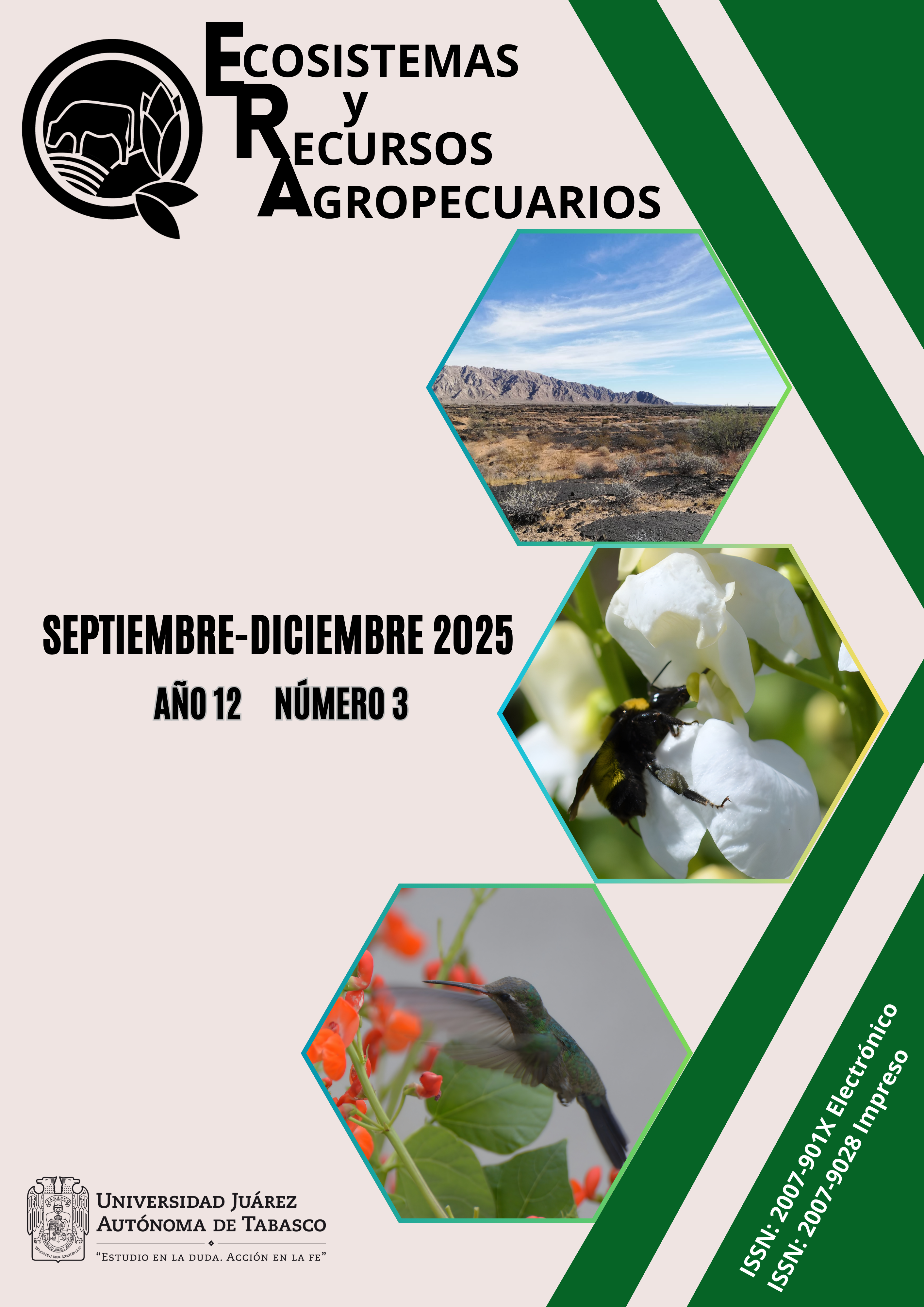Digital image analysis and composition of the 9-11th rib section from Black Belly sheep carcasses
DOI:
https://doi.org/10.19136/era.a12n3.4507Keywords:
Carcass characteristics, ImageJ software, meat sheep, tropical sheepAbstract
The relationship between digital image analysis of rib sections 9th-11th and its tissue composition in Black Belly lambs was evaluated. Twenty lambs were slaughtered, and rib sections 9-11 were removed from the left side of the carcass. Images of 9th-11th rib sections were taken and processed using ImageJ software to measure characteristics such as length (Rl) and area (Ra) of sections 9th-11th, depth (LTd), width (LTw) and area (LTa) of the longissimus thoracis muscle. Significant correlations were found between image measurements and characteristics of rib sections 9-11 (0.71 ≤ r ≤ 0.84, P < 0.05). The results indicate that digital image analysis of rib sections 9th-11th can be a useful tool for predicting tissue composition in lamb carcasses.
Downloads
References
Brito LS, da Silva Cavalcante AK, Rodrigues AS, Ferraz PA, Bittencourt RF, Junior LDPM, de Lisboa Ribeiro Filho A (2022) Evaluation of ImageJ software in ultrasonic image analysis: Follicular and luteal morphological characteristics of cattle. Animal Reproduction Science 236: 106907. https://doi.org/10.1016/j.anireprosci.2021.106907
Chay-Canul AJ, González JT, Canul-Solís J, Casanova-Lugo F, Piñeiro-Vázquez ÁT, Portillo-Salgado R, García-Herrera R, Vargas-Bello-Pérez E (2023) Predictive biometrics of hair sheep through digital imaging. Veterinaria México OA 10. https://doi.org/10.22201/fmvz.24486760e.2023.1150.
Cross HR, Gilliland DA, Durland PR, Seideman SC (1983) Beef carcass evaluation by use of a video image analysis system. Journal of Animal Science 57: 908-917. https://doi.org/10.2527/jas1983.574908x.
Du CJ, Sun DW (2004) Recent developments in the applications of image processing techniques for food quality evaluation. Trends in Food Science & Technology 15(5): 230-249. https://doi.org/10.1016/j.tifs.2003.10.006.
Escalante-Clemente S, Vázquez-Jiménez S, López-Durán SK, Arcos-Alvarez DN, Arbez-Abnal TA, Piñeiro-Vazquez ÁT, Muñoz-Benítez Alfonso L., Vargas-Bello-Pérez E, Chay-Canul AJ, (2022) Using the 9th–11th rib section to predict carcase tissue composition in Blackbelly sheep. Italian Journal of Animal Science 21(1): 161-167. https://doi.org/10.1080/1828051X.2021.2002731.
Font-i-Furnols M, Tous N, Esteve-Garcia E, Gispert M (2012) Do all the consumers accept marbling in the same way? The relationship between eating and visual acceptability of pork with different intramuscular fat content. Meat Science 91(4): 448-453. https://doi.org/10.1016/j.meatsci.2012.02.030.
Giaretta E, Mordenti AL, Canestrari G, Brogna N, Palmonari A, Formigoni A (2018) Assessment of muscle Longissimus thoracis et lumborum marbling by image analysis and relationships between meat quality parameters. PLoS One 13(8): e0202535. https://doi.org/10.1371/journal.pone.0202535.
Kucha CT, Liu L, Ngadi MO (2018) Non-destructive spectroscopic techniques and multivariate analysis for assessment of fat quality in pork and pork products: A review. Sensors 18(2): 377. https://doi.org/10.3390/s18020377.
Olsen EV, Christensen LB, Nielsen DB (2017) A review of computed tomography and manual dissection for calibration of devices for pig carcass classification-Evaluation of uncertainty. Meat Science 123: 35-44. https://doi.org/10.1016/j.meatsci.2016.08.013.
Pimentel VM, Geraldo AT, Costa RLD, Ferreira J, Beltrame RT, Madella-Oliveira AF, Quirino CR (2023) Using real-time ultrasound for in vivo estimates of Longissimus dorsi muscle parameters and fat thickness in Dorper ewes. Small Ruminant Research 220: 106930. https://doi.org/10.1016/j.smallrumres.2023.106930.
Ramos-Ramos C, Zaragoza-Vera CV, Zaragoza-Vera M, Torres-Chable O, Barrientos-Medina RC, Chay-Canul AJ (2024) Similarity of longissimus thoracis parameters and fat thickness measured by ultrasound and digital image analysis. Ecosistemas y Recursos Agropecuarios 11(3): 21. 10.19136/era.a11n3.4226.
R Core Team (2024) R: A language and environment for statistical computing. R Foundation for Statistical Computing, Vienna, Austria. https://www.R-project.org/. Data consulted: May 23, 2025.
Shackelford SD, Wheeler TL, Koohmaraie M (1998) Coupling of image analysis and tenderness classification to simultaneously evaluate carcass cutability, longissimus area, subprimal cut weights, and tenderness of beef. Journal of Animal Science 76(10): 2631-2640. https://doi.org/10.2527/1998.76102631x.
Silva SR, Almeida M, Condotta I, Arantes A, Guedes C, Santos V (2021) Assessing the feasibility of using kinect 3D images to predict light lamb carcasses composition from leg volume. Animals 11(12): 3595. https://doi.org/10.3390/ani11123595.
Sousa, A. R., Campos, A. C. N., Silva, L. P., Bezerra, L. R., Furtado, R. N., Oliveira, R. L., Pereira, E. S. (2020). Prediction of the chemical body composition of hair lambs using the composition of a rib section. Small Ruminant Research 191: 106189. https://doi.org/10.1016/j.smallrumres.2020.106189.
Teira GA, Tinois E, Lotufo RDA, Felício PED (2003) Digital-image analysis to predict weight and yields of boneless subprimal beef cuts. Scientia Agricola 60: 403-408. https://doi.org/10.1590/S0103-90162003000200028.
Xu Z, Han Y, Zhao D, Li K, Li J, Dong J, Shi W, Zhao H, Bai Y (2024) Research progress on quality detection of livestock and poultry meat based on machine vision, hyperspectral and multi-source information fusion technologies. Foods 13(3): 469. https://doi.org/10.3390/foods13030469.
Downloads
Published
Issue
Section
License
Copyright (c) 2025 Ecosistemas y Recursos Agropecuarios

This work is licensed under a Creative Commons Attribution-NonCommercial-NoDerivatives 4.0 International License.
Aviso de copyright
Los autores que se envían a esta revista aceptan los siguientes términos:
una. Los autores conservan los derechos de autor y garantizan a la revista el derecho a ser la primera publicación del trabajo con una licencia de atribución de Creative Commons que permite a otros compartir el trabajo con un reconocimiento de la autoría del trabajo y la publicación inicial en esta revista.
B. Los autores pueden establecer acuerdos complementarios separados para la distribución no exclusiva de la versión del trabajo publicado en la revista (por ejemplo, en un repositorio institucional o publicarlo en un libro), con un reconocimiento de su publicación inicial en esta revista.
C. Se permite y se anima a los autores a difundir su trabajo electrónicamente (por ejemplo, en repositorios institucionales o en su propio sitio web) antes y durante el proceso de envío, ya que puede conducir a intercambios productivos, así como a una cita más temprana y más extensa del trabajo publicado. (Consulte El efecto del acceso abierto).

